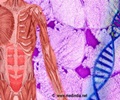The new study reveals the relationship between somatic—not inherited—genetic mutations and schizophrenia risk.

Schizophrenia-associated somatic copy-number variants from 12,834 cases reveal recurrent NRXN1 and ABCB11 disruptions
Go to source). “We originally thought of genetics as the study of inheritance. But now we know that genetic mechanisms go way beyond that,” says senior author Chris Walsh, an investigator at the Howard Hughes Medical Institute and chief of genetics and genomics at Boston Children’s Hospital. “We’re looking at mutations that are not inherited from the parents.”
‘A new study links schizophrenia with somatic NRXN1 mutations, rather than inherited ones. #schizophrenia #psychiatricdisorder #somaticmutations’





The researchers analyzed genotype-marker data from over 20,000 blood samples of people with or without schizophrenia from the Psychiatric Genomics Consortium. They ultimately identified two genes—NRXN1 and ABCB11—that correlated with schizophrenia cases when disrupted in utero. NRXN1, a gene that helps transmit signals throughout the brain, has been associated with schizophrenia before.
In Utero Somatic Mutations: A Potential Contributor to Schizophrenia Risk
Unlike inherited mutations, which are present in all the cells of the body, somatic mutations are only present in a fraction of cells based on when and where a mutation occurred. If a mutation occurs early in development, it is expected that the variant is present throughout the body in a mosaic pattern. On the basis of this principle, researchers can identify somatic mutations that occurred early in development and are present not only in the brain but also in a fraction of cells in the blood.“If a mutation occurs after fertilization when there are only two cells, the mutation will be present in half of the cells of the body,” says Walsh. “If it occurs in one of the first four cells, it will be present in about a quarter of the cells of the body, and so on.”
The second gene the researchers identified, ABCB11, is most known to encode a liver protein. “That one came out of nowhere for us,” says Eduardo Maury, a student in Harvard-MIT’s MD-PhD program. “There have been some studies associating mutations in this gene with treatment-resistant schizophrenia, but it hasn’t been strongly implicated in schizophrenia per se.”
When the team investigated further, they found that ABCB11 is also expressed in very specific subsets of neurons that carry dopamine from the brainstem to the cerebral cortex. Most schizophrenia drugs are thought to act on these cells to decrease an individual’s dopamine levels, so this might explain why the gene is associated with treatment resistance.
Next, the team is working towards identifying other acquired mutations that might be associated with schizophrenia. Given that the study analyzed blood samples, it will be important to look at more brain-specific mutations that might have been too subtle or recent in a patient’s life for this analysis to detect. In addition, somatic deletions or duplications might be an under-investigated risk factor associated with other disorders.
Advertisement
Reference:
- Schizophrenia-associated somatic copy-number variants from 12,834 cases reveal recurrent NRXN1 and ABCB11 disruptions - (https://www.sciencedirect.com/science/article/pii/S2666979X23001398?via%3Dihub)














